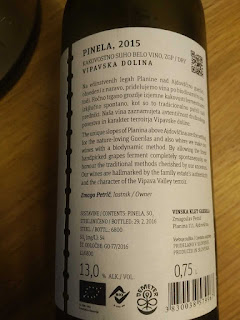Always conscious of how difficult it is to find wines that are not over-extracted high alc. fruit bombs, we tend towards lighter wines even out of summer. So our summer drinking is super-light in the main which is even more difficult to come by.
2017 found us buying a selection from a company called Meteri based in the Veneto who specialise in Natural Wine. Some of this was so light as to be on the watery side but there were nice discoveries along the way including not-so-light and aromatic finds
Garganega is a grape we like more and more. This unfiltered natural example had plenty of character despite an Abv. of 11.5%.
Zelen is a grape we have enjoyed before and this biodynamic example by Vipavska Dolina, Slovenia was very amiable despite its name - Guerila.
From the same producer we bought a Pinela This grape is not that rare but is not very often encountered. It is all right but really nothing special.
Albana is even less obscure but somehow we have never managed to get a handle on it. Perhaps we have been put off by the fact it is normally quite high in alcohol but this bottle by Vignie del Bosco, called Persefone for some reason is a real aromatic cracker. Strangely Vigne del Bosco's website doesn't mention it and Albana doesn't feature in the varieties that go into any of their other wines.
Found in London, this orange Grecanico from Cos hit the summery spot very nicely. What a great producer Cos is, making all that women's and men's apparel too!
It's now OK to take English wine seriously thank goodness. We have been doing so for years. This is an interesting blend of Pinot Blanc and Pinot Meunier which we have enjoyed in previous summers.
Another good English white from M & S was this Champagne grape effort from Plumpton College. It's strange that the Chardonnay/Pinot Noir/Pinot Meunier formula isn't made more often. Since the UK's profile as a producer of sparkling wines seems to have outsripped that of still wine, why not pursue this blend. It could be given a name like Meritage and become a sort of brand. Just a thought.
 | |||||||||||||||||
| 12.5% |
We finally drank the bottle of Alsace Pinot Noir from Domaine de l'Oriel. This had been our winner from the Salon des vins des vignerons independants in Paris, 2016. We made the mistake of chilling the bottle. This stripped all flavour from the wine which is really delicious but delicate. Once free of hypothermia the wine shone as we remembered it.
From delicate to ueber-aomatic. This is the bottle that Jeanne from Versant Vins in the Marche aux Enfants rouges in Paris only sold us on the strict instruction that it was not to be drunk for at least 6 months. The time was well and truly up and the result was truly tongue-tickling. We can't imagine how it would have tasted at the time of purchase but Jeanne knows what she is talking about and who were we to disobey her?
The blend is very imaginative: Menu Pineau, Baco Blanc, Gaillard and Meslier Saint Francois. How many wines have you drunk made with those? The winemaker is Olivier Lemasson, a former sommelier who now is famous as a negociant in the Loire producing biological vins de France inmultiple blends of grapes such as Romorantin, Pineau d'Aunis, Gamay, Grolleau and Cot as well as the above.
Kakotrygis is the main white grape variety of Corfu apparently. We picked up this bottle at Athens Duty Free whose selection was otherwise not very exciting. Really rather good.
Wine writers sometimes like to use the word 'thirst' in their descriptions. Other than figuratively, we don't like to do so ourselves. Thirst should be slaked with water or some other non-alcoho;ic drink. Having said that, beer is a great thirst quencher but then we wouldn't want to be drinking wine at the saem time.
We have tried various de-alcoholised wines before including this Muscat from Torres and found them unpalatable. Nonetheless, such is our respect for Torres that we thought we'd give their Natureo another go. Opinion was divided but for some it wasn't a bad accompaniment to Sag King Prawn when chilled to within an inch before frozen. You can drink this on like grape juice and as such, we can allow it to quench a thirst. Abv. 0.5% though, so go easy.


















































